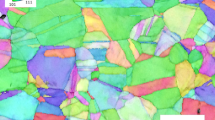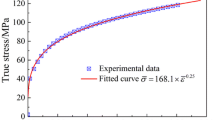Abstract
Background
The burst testing technique is used to determine the failure hoop stress of tubes that are subjected to internal pressure. In that technique, the tube is subjected to internal high fluid pressure until it bursts. This testing technique is costly and is not suitable if the available tube material is limited.
Objective
In this paper, a novel design of a ring expansion testing rig is presented to replace the burst testing technique for determining the failure hoop stress of circular uniform thin-walled ring specimens where t/d < 1/20; t is the wall thickness and d is the outer diameter of the ring. In addition, the ring expansion testing technique can be used to measure the mechanical properties of the tube material.
Methods
The testing rig consists of a multipiece mandrel assembled with two cones that are moving against the mandrel in opposite directions. The ring of the tested tube circumscribes the mandrel and deforms radially as the cones move axially against the mandrel. In addition to experiments, numerical analyses were carried out using the commercial finite element method (FEM) package ABAQUS. The FEM was used to optimize the mandrel design in terms of the optimum number of the mandrel pieces.
Results
The FEM revealed that at least six mandrel pieces should be employed in order to produce uniform hoop stress in the ring specimens. In addition, the FEM results were utilized in conjunction with the theoretical results to find the value of the shear factor (α = 0.06). The experimental results highlighted the effects of the ring cross-section dimensions on the obtained results.
Conclusions
It is concluded that the greater the number of mandrel pieces is, the more uniform the distribution of the hoop stress developed in the ring and, hence, the more accurate the determined hoop stress. In addition, the numerical and experimental results can be used to determine the coefficient of friction between the rig's contact surfaces of the test unit.

















Similar content being viewed by others
Abbreviations
- d [mm] :
-
Inner diameter of the ring specimen
- E Aluminum :
-
Modulus of elasticity of Aluminum
- E Steel :
-
Modulus of elasticity of Steel
- F [N] :
-
External applied force to the cones
- F x [N] :
-
Projection of F on the horizontal axis (X)
- F y [N] :
-
Projection of F on the vertical axis (Y)
- h [mm] :
-
Height of the ring specimen
- N 1 [N] :
-
Normal force acting on the mandrel inner surface
- N 2 [N] :
-
Normal force acting on the ring inner surface
- P [Pa] :
-
Internal pressure
- P' [Pa] :
-
Nominal pressure on the ring inner surface
- r [mm] :
-
Inner radius of the ring
- t [mm] :
-
Wall thickness of the ring specimen
- α :
-
Shear factor
- σ θ :
-
Hoop stress
- µ 1 :
-
Coefficient of friction between the cone and the mandrel surfaces
- µ 2 :
-
Coefficient of friction between the ring and the mandrel surfaces
- v Aluminum :
-
Poisson ration of Aluminum
- v Steel :
-
Poisson ration of Steel
- θ [°] :
-
Taper angle of the cone and of the mandrel tapered hole
References
Matar W, Murphy F, Pierru A, Rioux B (2015) Lowering saudi arabia’s fuel consumption and energy system costs without increasing end consumer prices. Energy Econ 49:558–569
Li YL, Zhao XL, Singh Raman RK (2018) Mechanical properties of seawater and sea sand concrete-filled frp tubes in artificial seawater. Constr Build Mater 191:977–993
Malekan M, Khosravi A, Cimini CA (2019) Deformation and fracture of cylindrical tubes under detonation loading: a review of numerical and experimental analyses. Int J Press Vessels Pip 173:114–132
Le Saux M, Besson J, Carassou S (2015) A model to describe the mechanical behavior and the ductile failure of hydrided zircaloy-4 fuel claddings between 25 °C and 480 °C. J Nucl Mater 466:43–55
Desquines J, Koss DA, Motta AT, Cazalis B, Petit M (2011) The issue of stress state during mechanical tests to assess cladding performance during a reactivity-initiated accident (ria). J Nucl Mater 412(2):250–267
Jiang H, Wang J-AJ (2014) Methodology for mechanical property testing of fuel cladding using an expanding plug wedge test. J Nucl Mater 446(1):27–37
Nilsson K-F, Martin O, Chenel-Ramos C, Mendes J (2011) The segmented expanding cone-mandrel test revisited as material characterization and component test for fuel claddings. Nucl Eng Des 241(2):445–458
Jiang H, Wang J-AJ (2018) Development of cone-wedge-ring-expansion test to evaluate the tensile hoop properties of nuclear fuel cladding. Prog Nucl Energy 108:372–380
Hearn EJ (2000) Mechanics of Materials, 3rd edn. Butterworth-Heinemann, Oxford
Acknowledgment
The authors acknowledge the Deanship of Scientific Research at King Faisal University for financial support under Nasher Track (Grant No. 186327)
Author information
Authors and Affiliations
Corresponding author
Ethics declarations
Conflict of Interest
The authors have no conflicts of interest to declare that are relevant to the content of this article.
Rights and permissions
About this article
Cite this article
Saber, M., Chouikhi, H. Development of the Bicone Mandrel Ring Expansion Test to Evaluate the Hoop Stress in Extruded Aluminum Tubes. Exp Mech 61, 791–802 (2021). https://doi.org/10.1007/s11340-021-00692-y
Received:
Accepted:
Published:
Issue Date:
DOI: https://doi.org/10.1007/s11340-021-00692-y




